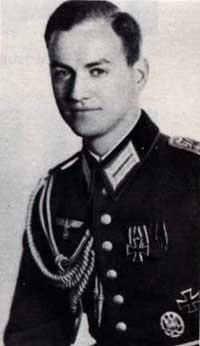Leutnant Sigfried Knappe

As a young artillery Leutnant Sigfried Knappe participated in the invasion of France as part of Army Group Kleist. He was decorated for actions that took place on the night of June 14, 1940, in the Paris area, south of Tremblay, at the Ourcq canal. A group of French Sailors had apparently not been informed of the decision to declare Paris an open city and were defending a bridge with machine guns from a house across the canal. After German infantry failed to clear the area with mortar fire, Artillery support was requested. Though Leutnant Knappe was the Battalion Adjutant and it was not his duty to man the gun, he moved up to the front with the infantry. Because the area was wooded the 105mm gun had to be brought up and fired almost at point blank range directly into the house. The German infantry was hidden behind a building by the bridge, where the gun was maneuvered, but in order to fire all seven crew members would be exposed to machine gun fire. On the mark the gun was moved, aimed, and fired. Three of the seven crew members were wounded but the machine gun nest was destroyed, opening the road for the infantry. Leutnant Knappe was wounded with a bullet entering on the back of his hand and exiting through his wrist. He was evacuated and for his bravery received the Iron Cross 2nd Class on June 19, as well as the Black Wound Badge for his wounds.Leutnant Knappe would go on to fight in the Russian and Italian fronts. While participating in the invasion of the Soviet Union in 1941, he would receive the Iron Cross 1st class for his bravery, in particular for leading artillery attacks from forward positions. He would also be wounded an additional two times in the course of his career. After attending General Staff College he would climb to the rank of Major and ended the war fighting in Berlin on General Weidlings staff. After surviving Russian captivity, he moved to the U.S. with his family and has written a book about his experiences.
Top of Page
![]()
© Copyright Wehrmacht-Awards.com LLC |
